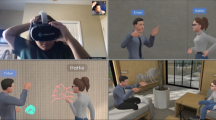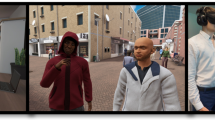Abstract
Technologies are being used increasingly to aid psychotherapy and are becoming an integral part of mental health treatment. Although prior studies compared technology-aided psychotherapy (TAP) to traditional treatments, there are insufficient studies of the impact that specific design parameters and use of the technologies may have on the client and therapist, and treatment outcomes. This requires an understanding of human–technology interaction, which is the focus of the field of Human Factors and Ergonomics (HF/E). The goal of this article is to raise awareness of the importance of the human–technology interaction in TAP, and to foster collaborations between psychotherapists and HF/E professionals. Toward these aims, this article examines the implications of findings in HF/E for the use of technologies (videoconferencing, text-based communication, and virtual environments) in psychotherapy. It is suggested that the manner in which technologies are designed and used may have important effects on the therapeutic alliance and treatment outcomes, and in some cases (side effects of virtual reality) the health and safety of the client. Future research should examine effects of specific design factors on treatment including variables such as the visibility of gestures and degree of eye contact during videoconferencing, response delays during text-messaging, and presence and adverse effects when using virtual environments. Studies that compare TAP to traditional methods should report as much detail as possible about the human–technology interaction. It is essential that psychotherapists and HF/E professionals conduct research collaboratively to develop effective and innovative technologies and, ultimately, design principles for TAP.
Similar content being viewed by others
References
Alsina-Jurnet, I., & Gutiérrez-Maldonado, J. (2010). Influence of personality and individual abilities on the sense of presence experienced in anxiety triggering virtual environments. International Journal of Human–Computer Studies, 68, 788–801.
Anderson, R. E. E., Spence, S. H., Donovan, C. L., March, S., Prosser, S., & Kenardy, J. (2012). Working alliance in online cognitive behavior therapy for anxiety disorders in youth: Comparison with clinic delivery and its role in predicting outcome. Journal of Medical Internet Research, 14, e88.
Argyle, M. (1972). The psychology of interpersonal behavior (2nd ed.). London: Cox & Wyman.
Arnd-Caddigan, M. (2012). The therapeutic alliance: Implications for therapeutic process. Journal of Contemporary Psychotherapy, 42, 477–485.
Backhaus, A., Agha, Z., Maglione, M. L., Ross, B., Zuest, D., Rice-Thorp, N. M., et al. (2012). Videoconferencing psychotherapy: A systematic review. Psychological Services, 9, 111–131.
Barak, A., Hen, L., Boniel-Nissim, M., & Shapira, N. (2008). A comprehensive review and meta-analysis of the effectiveness of Internet-based psychotherapeutic interventions. Journal of Technology in Human Services, 26, 109–160.
Bee, P. E., Bower, P., Lovell, K., Gilbody, S., Richards, D., Gask, L., et al. (2008). Psychotherapy mediated by remote communication technologies: A meta-analytic review. BMC Psychiatry, 8, 1–13.
Bee, P. E., Lovell, K., Lidbetter, N., Easton, K., & Gask, L. (2010). You can’t get anything perfect: User perspectives on the delivery of cognitive behavioural therapy by telephone. Social Science and Medicine, 71, 1308–1315.
Bradner, E. & Mark, G. (2002). Why distance matters: Effects on cooperation, persuasion and deception. Proceedings of the 2002 ACM Conference on Computer Supported Cooperative Work (pp. 226–235). New York: ACM Press.
Bray, J. H. (2010). The future of psychology practice and science. American Psychologist, 65, 355–369.
Brenes, G. A., Ingram, C. W., & Danhauer, S. C. (2011). Benefits and challenges of conducting psychotherapy by telephone. Professional Psychology: Research and Practice, 42, 543–549.
Chartrand, T. L., & Bargh, J. A. (1999). The chameleon effect: The perception-behavior link and social interaction. Journal of Personality and Social Psychology, 76, 893–910.
Clough, B. A., & Casey, L. M. (2011a). Technological adjuncts to enhance current psychotherapy practices: A review. Clinical Psychology Review, 31, 279–292.
Clough, B. A., & Casey, L. M. (2011b). Technological adjuncts to increase adherence to therapy: A review. Clinical Psychology Review, 31, 697–710.
Cooke, N. J., & Durso, F. T. (2008). Stories of modern technology failures and cognitive engineering successes. Boca Raton: CRC Press.
DeLucia, P. R., & Harold, S. A. (2011). Should Human Factors/Ergonomics Go to Therapy? Bulletin of the Human Factors and Ergonomics Society, 54, 1–2.
Derrer, N. M., Fullwood, C., Davis, S. J., Martino, O. I., & Morris, N. (2006). An initial face-to-face meeting improves person perceptions of interviewees across VMC. In P. D. Bust (Ed.), Contemporary Ergonomics 2006 (pp. 296–298). Great Britain: Taylor & Francis.
Doherty, G., Coyle, D., & Matthews, M. (2010). Design and evaluation guidelines for mental health technologies. Interacting with Computers, 22, 243–252.
Driskell, J. E., & Radtke, P. H. (2003). The effect of gesture on speech production and comprehension. Human Factors, 45, 445–454.
Emmelkamp, P. M. G. (2005). Technological innovations in clinical assessment and psychotherapy. Psychotherapy and Psychosomatics, 74, 336–343.
Fussell, S. R., & Benimoff, N. I. (1995). Social and cognitive processes in interpersonal communication: Implications for advanced telecommunications technologies. Human Factors, 37, 228–250.
García-Linzana, F., & Muñoz-Mayorga, I. (2010). Telemedicine for depression: A systematic review. Perspectives in Psychiatric Care, 46, 119–126.
Hancock, P. A., Pepe, A. A., & Murphy, L. L. (2005). Hedonomics: The power of positive and pleasurable ergonomics. Ergonomics in Design, 13, 8–14.
Hemsley, G. D., & Doob, A. N. (1978). The effect of looking behavior on perceptions of a communicator’s credibility. Journal of Applied Social Psychology, 8, 136–144.
Jerome, L. W., & Zaylor, C. (2000). Cyberspace: Creating a therapeutic environment for telehealth applications. Professional Psychology: Research and Practice, 31, 478–483.
Johnson, J. H., Godin, S. W., & Bloomquist, M. L. (1981). Human factors engineering in computerized mental health care delivery. Behavior, Research Methods & Instrumentation, 13, 425–429.
Joinson, A. N. (2001). Self-disclosure in electronically-mediated communication: The role of self-awareness and visual anonymity. European Journal of Social Psychology, 31, 177–192.
Kantowitz, B. H., Roediger, H. L., & Elmes, D. G. (2009). Experimental Psychology (9th ed.). Belmont: Wadsworth.
Kennedy, R. S., Lane, N. E., Berbaum, K. S., & Lilienthl, M. G. (1993). Simulator sickness questionnaire: An enhanced method for quantifying simulator sickness. International Journal of Aviation Psychology, 3, 203–220.
Krijn, M., Emmelkamp, P. M. G., Biemond, R., de Wilde de Ligny, C., Schuemie, M. J., & van der Mast, C. A. P. G. (2004). Treatment of acrophobia in virtual reality: The role of immersion and presence. Behaviour Research and Therapy, 42, 229–239.
Manning, T. R., Goetz, E. T., & Street, R. L. (2000). Signal delay effects on rapport in telepsychiatry. CyberPsychology & Behavior, 3, 119–127.
Meyerbröker, K., & Emmelkamp, P. M. G. (2010). Virtual reality exposure therapy in anxiety disorders: A systematic review of process-and-outcome studies. Depression and Anxiety, 27, 933–944.
Moon, Y. (1999). The effects of physical distance and response latency on persuasion in electronically-mediated communication and human–computer communication. Journal of Experimental Psychology: Applied, 5, 379–392.
Nelson, E.-L., Barnard, M., & Cain, S. (2003). Treating childhood depression over videoconferencing. Telemedicine Journal and e-Health, 9, 49–55.
Nelson, E.-L., Bui, T. N., & Velasquez, S. E. (2011). Telepsychology: Research and Practice Overview. Child and Adolescent Psychiatric Clinics of North America Journal, 20, 67–79.
Nisbett, R. E. (2003). The geography of thought: How Asians and Westerners think differently and why. New York: The Free Press.
Opris, D., Pintea, S., García-Palacios, A., Botella, C., Szamöskozi, S., & David, D. (2012). Virtual reality exposure therapy in anxiety disorders: A quantitative meta-analysis. Depression and Anxiety, 29, 85–93.
Parsons, T. D., & Rizzo, A. A. (2008). Affective outcomes of virtual reality exposure therapy for anxiety and specific phobias: A meta-analysis. Journal of Behavior Therapy and Experimental Psychiatry, 39, 250–261.
Paxton, S. J., McLean, S. A., Gollings, E. K., Faulkner, C., & Wertheim, E. H. (2007). Comparison of face-to-face and Internet interventions for body image and eating problems in adult women: An RCT. International Journal of Eating Disorders, 40, 692–704.
Powers, B. M., & Emmelkamp, P. M. G. (2008). Virtual reality exposure therapy for anxiety disorders: A meta-analysis. Journal of Anxiety Disorders, 22, 561–569.
Rappaport, M. (1970). Human factors applications in medicine. Human Factors, 12, 25–35.
Rice, R. E., & Stohl, C. (2006). Communication and Human Factors. In G. Salvendy (Ed.), Handbook of human factors and ergonomics (3rd ed., pp. 150–176). Hoboken: Wiley.
Rocco, E. (1998, April). Trust breaks down in electronic contexts but can be repaired by some initial face-to-face contact. Paper presented at the ACM SIGCHI Conference on Human Factors in Computing Systems, Los Angeles.
Rothbaum, B. O., Anderson, P., Zimand, E., Hodges, L., Lang, D., & Wilson, J. (2006). Virtual reality exposure therapy and standard (in vivo) exposure therapy in the treatment of fear of flying. Behavior Therapy, 37, 80–90.
Sadowski, W., & Stanney, K. M. (2002). Presence in virtual environments. In K. M. Stanney (Ed.), Handbook of virtual environments: Design, implementation, and applications (pp. 791–806). Mahwah: Erlbaum.
Simpson, S. (2009). Psychotherapy via videoconferencing: A review. British Journal of Guidance & Counselling, 37, 271–286.
Stanney, K. M., & Cohn, J. (2006). Virtual Environments. In G. Salvendy (Ed.), Handbook of human factors and ergonomics (pp. 1079–1096). Hoboken: Wiley.
Stanney, K. M., Graeber, D. A., & Kennedy, R. S. (2006). Virtual environment usage protocols. In W. Karwowski (Ed.), Handbook of Standards and Guidelines in Ergonomics and Human Factors (pp. 381–397). Mahwah: Lawrence Erlbaum.
Suwita, A., Böcker, M., Mühlbach, L., & Runde, D. (1997). Overcoming human factors deficiencies of videocommunications systems by means of advanced image technologies. Displays, 17, 75–88.
Tam, T., Cafazzo, J. A., Seto, E., Salenieks, M. E., & Rossos, P. G. (2007). Perception of eye contact in video teleconsultation. Journal of Telemedicine and Telecare, 13, 35–39.
Tang, Y., Zhang, W., Chen, K., Feng, S., Ji, Y., Shen, J., et al. (2006). Arithmetic processing in the brain shaped by cultures. Proceedings of the National Academy of Sciences, 103, 10775–10780.
Tidwell, L. C., & Walther, J. B. (2002). Electronically-mediated communication effects on disclosure, impressions, and interpersonal evaluations: Getting to know one another a bit at a time. Human Communication Research, 28, 317–348.
Titov, N. (2011). Internet-delivered psychotherapy for depression in adults. Current Opinion in Psychiatry, 24, 18–23.
Wickens, C. D., Gordon, S. E., & Liu, Y. (1998). An introduction to human factors engineering. New York: Addison Wesley Longman.
Witmer, B. G., & Singer, M. J. (1998). Measuring presence in virtual environments: A presence questionnaire. Presence, 7, 225–240.
Yellowlees, P., Shore, J., & Roberts, L. (2010). Practice guidelines for videoconferencing-based telemental health—October 2009. Telemedicine and e-Health, 16, 1075–1089.
Youngblut, C. (2006). What a decade of experiments reveals about factors that influence the sense of presence. Virginia: Institute for Defense Analyses.
Acknowledgments
Patricia R. DeLucia, Stephanie A. Harold, Yi-Yuan Tang, Department of Psychology, Texas Tech University. Patricia R. DeLucia served as president of Division 21 of the American Psychological Association in 2010–2011. This article is based on her presidential address for Division 21, presented at APA’s 119th Annual Convention on August 4, 2011, in Washington, D.C. We are grateful to Patrick Crittendon for help with the literature review and to the students and faculty in the Texas Tech University Human Factors Chat for feedback on the presentation.
Author information
Authors and Affiliations
Corresponding author
Rights and permissions
About this article
Cite this article
DeLucia, P.R., Harold, S.A. & Tang, YY. Innovation in Technology-Aided Psychotherapy Through Human Factors/Ergonomics: Toward a Collaborative Approach. J Contemp Psychother 43, 253–260 (2013). https://doi.org/10.1007/s10879-013-9238-8
Published:
Issue Date:
DOI: https://doi.org/10.1007/s10879-013-9238-8




